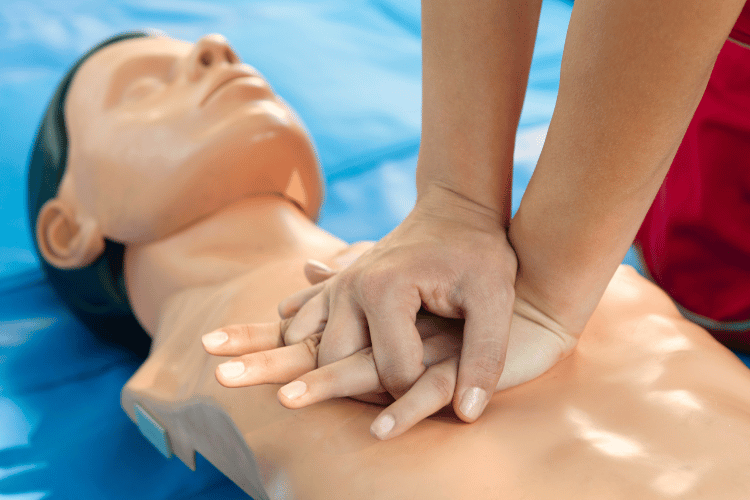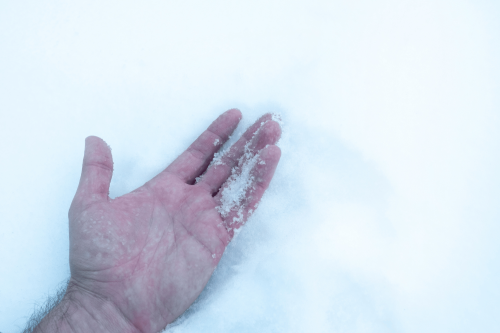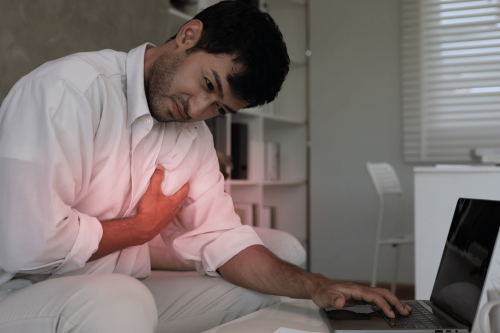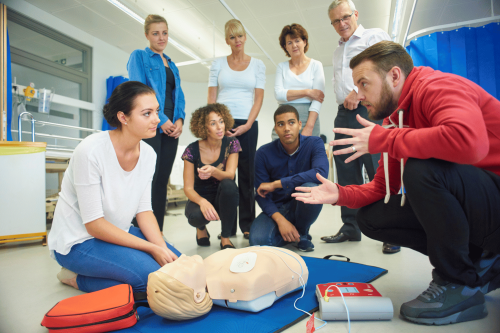
Knowing how to act quickly can mean the difference between life and death when emergencies strike. One such critical situation arises when a person has a pulse but isn’t breathing. This condition, known as respiratory arrest, requires immediate action to prevent irreversible damage. Cardiopulmonary Resuscitation (CPR) is one of the most essential life-saving techniques in this scenario. It keeps oxygen flowing to vital organs like the brain and heart until professional help arrives.
This guide will explain the vital role of CPR in cases of respiratory arrest, breaking down the steps involved, the science behind its effectiveness, and the actions you should take before and after performing it. Whether you're a trained professional or a concerned bystander, understanding CPR’s function and application will empower you to respond effectively when it matters most.
What Is CPR and Why Is It Important?
Cardiopulmonary Resuscitation, commonly known as CPR, is a life-saving technique used during emergencies when someone is unresponsive, not breathing, or their heart has stopped. CPR combines chest compressions and rescue breaths to maintain blood circulation and oxygen delivery to critical organs until advanced medical care becomes available.
Why Is CPR Crucial in Emergencies?
- Maintains oxygen flow: Without oxygen, the brain begins to suffer damage within 4 to 6 minutes; CPR buys precious time by keeping oxygenated blood circulating.
- Prevents cardiac arrest: Without breathing, the heart will eventually stop. CPR helps delay this progression.
- Improves survival rates: Immediate CPR can double or triple survival chances in emergencies like drowning, drug overdoses, or choking.
Every second counts in emergencies; even an untrained bystander attempting CPR can make a critical difference.
Understanding the Critical Window: Pulse but No Breathing
When a person has a pulse but isn’t breathing, they are in respiratory arrest. Here’s what happens physiologically:
- Oxygen stops flowing to the brain and body.
- Carbon dioxide builds up, leading to acidosis, or a dangerous drop in blood pH.
- Brain and heart cells begin to deteriorate, and within minutes, the heart will likely stop beating, resulting in cardiac arrest.
The Role of Rescue Breaths
Rescue breaths are an essential component of CPR for cases where a pulse is present but breathing has stopped. Here’s why they matter:
- They supply oxygen: Breaths provide the oxygen that the lungs cannot inhale naturally.
- They prevent hypoxia: Without oxygen, the brain and heart cells start dying quickly.
- Science supports their importance: Research shows that early intervention with rescue breaths significantly improves survival and recovery rates, particularly in cases involving respiratory failure due to drowning or opioid overdoses.
Neglecting to perform rescue breathing can rapidly escalate a manageable scenario into a fatal one.
How to Check for Breathing and Pulse?
The first step in any emergency is to assess the situation and the individual’s condition. This ensures appropriate actions are taken without wasting precious time.
Steps to Check for Breathing:
- Position the person on their back. Make sure they are lying on a firm, flat surface.
- Open the airway. Tilt the head back and lift the chin to clear the passage.
- Look, listen, and feel. Look for chest movement, listen for breathing sounds, and feel for air from their nose or mouth.
- Spend no more than 10 seconds. If they are not breathing or only gasping, this qualifies as respiratory arrest.
How to Check for a Pulse:
- Locate the carotid artery. Place two fingers on the groove between the windpipe and the neck muscle.
- Press lightly. Please avoid using your thumb, as it has a detectable pulse.
- Wait 5–10 seconds. If no pulse is detected, move to chest compressions. If a pulse is present but breathing is absent, begin rescue breaths.
Quick and accurate assessment is critical to determine whether CPR or rescue breaths are needed.
Step-by-Step Guide to Performing CPR
If the person has no breathing and no pulse, follow these steps for CPR:
1. Begin Chest Compressions:
- Position your hands: Place the heel of one hand on the center of the chest, between the nipples. Place the second hand on top, interlocking fingers.
- Push hard and fast: Use your body weight to compress the chest approximately 2 inches deep at 100–120 compressions per minute. Songs like "Stayin’ Alive" can help maintain the pace.
2. Provide Rescue Breaths:
If trained:
- Open the airway by tilting the head back and lifting the chin.
- Pinch the nose shut and cover their mouth with yours to create a seal.
- Give two breaths, each lasting 1 second, and watch for chest rise.
- Continue with a cycle of 30 compressions and two breaths.
If untrained or unwilling to provide mouth-to-mouth:
- Perform hands-only CPR by focusing on chest compressions without rescue breaths. This is still effective in emergencies.
3. Use an AED If Available:
- Turn on the Automated External Defibrillator (AED).
- Follow the voice prompts to apply pads and administer shocks if advised.
- Resume CPR immediately after each shock.
Continue CPR until medical professionals take over, the person breathes again, or you become unable to continue.
The Science Behind CPR in Respiratory Arrest
The effectiveness of CPR lies in its ability to replicate the body’s natural processes temporarily:
- Circulation: Chest compressions manually pump blood through the heart and body.
- Oxygenation: Rescue breaths supply oxygen, critical for brain and heart function.
- Preventing cell death: Without oxygen, irreversible brain damage begins within minutes. CPR significantly slows this process.
Understanding the science reinforces the importance of proper technique and quick intervention.
What to Do After Performing CPR?
Once CPR has been performed, several immediate post-intervention steps can improve outcomes:
1. Monitor the Person
- Check for breathing and pulse: If they resume breathing, stop compressions but keep monitoring.
- Position safely: If breathing has returned, roll them onto their side in the recovery position to prevent choking.
2. Ensure Emergency Medical Services Are on Their Way
- Dial 911 or your local emergency number immediately if you haven’t already.
- Assign someone to guide paramedics to the scene if you’re in a hard-to-find location.
3. Do Not Stop Until Help Arrives
- Only stop CPR if professionals take over, the person recovers, or the scene becomes unsafe.
Being thorough after CPR can significantly impact the person’s recovery.
Frequently Asked Questions (FAQ)
Q: What should you do if a person is not breathing but has a detectable pulse?
A: If a person is not breathing but has a detectable pulse, you should provide rescue breathing. Begin by giving two rescue breaths, followed by one rescue breath every five to six seconds until the person starts breathing normally or emergency medical services arrive.
Q: How do you determine if someone is unconscious and not breathing?
A: To determine if someone is unconscious and not breathing, check for responsiveness by tapping their shoulder and shouting. If there is no response, check for normal breathing. If the person is not breathing or only gasping, it is crucial to begin CPR immediately.
Q: What are the steps to take when performing CPR on someone unconscious?
A: When performing CPR on an unconscious person, first ensure the scene is safe, then check for responsiveness. If the person is unconscious and not breathing, call for emergency medical services, begin CPR immediately, performing 30 chest compressions followed by two rescue breaths, and continue this cycle until help arrives or the person starts breathing normally.
Q: What is the recommended rate of chest compressions during CPR?
A: The recommended rate of chest compressions during CPR is between 100 to 120 compressions per minute. This rate helps to maintain adequate blood flow to the heart and brain during cardiopulmonary resuscitation.
Q: How can you tell if a person has stopped breathing?
A: You can tell if a person has stopped breathing by observing their chest for any rise and fall and listening for breath sounds. The absence of breathing, or gasping that is not normal breathing, indicates that the person is not breathing and requires immediate intervention.
Q: What is the significance of giving two rescue breaths during CPR?
A: Giving two rescue breaths during CPR is significant because it provides oxygen to the lungs, which can help sustain brain function until normal breathing resumes or emergency medical services arrive. It is particularly crucial if the person has a pulse but is not breathing.
Q: When should you continue CPR until emergency medical services arrive?
Q: When should you continue CPR until emergency medical services arrive?
A: You should continue CPR until emergency medical services arrive or the person begins to breathe normally. If the heart is still beating but the person isn’t breathing, rescue breathing should be provided. If at any point the person starts breathing or shows signs of consciousness, you should stop CPR.
Q: Why is training in CPR and first aid essential?
A: CPR and first aid training are necessary because they equip individuals with the skills needed to respond effectively in emergencies, such as when someone is unconscious and not breathing. This knowledge can significantly increase the chances of survival and reduce the risk of brain damage until professional help arrives.
Q: What should you do if you notice someone is breathing but has no pulse?
A: If you notice someone breathing but has a pulse, you should monitor their breathing and pulse closely. Ensure they are in a safe position, typically on their side, and be prepared to administer CPR if their breathing stops or becomes irregular.
Final Thoughts
CPR is a powerful tool that saves lives in critical emergencies. When a person has a pulse but isn’t breathing, rescue breaths play a vital role in sustaining oxygen flow until professional help arrives. By learning and applying these basic techniques, you can act confidently and decisively when faced with a life-threatening situation.
No one plans for an emergency, but being prepared can be a lifesaver. Take the time to get CPR training and equip yourself with the knowledge to step in when it matters most.








 Login with Google
Login with Google Login with Facebook
Login with Facebook